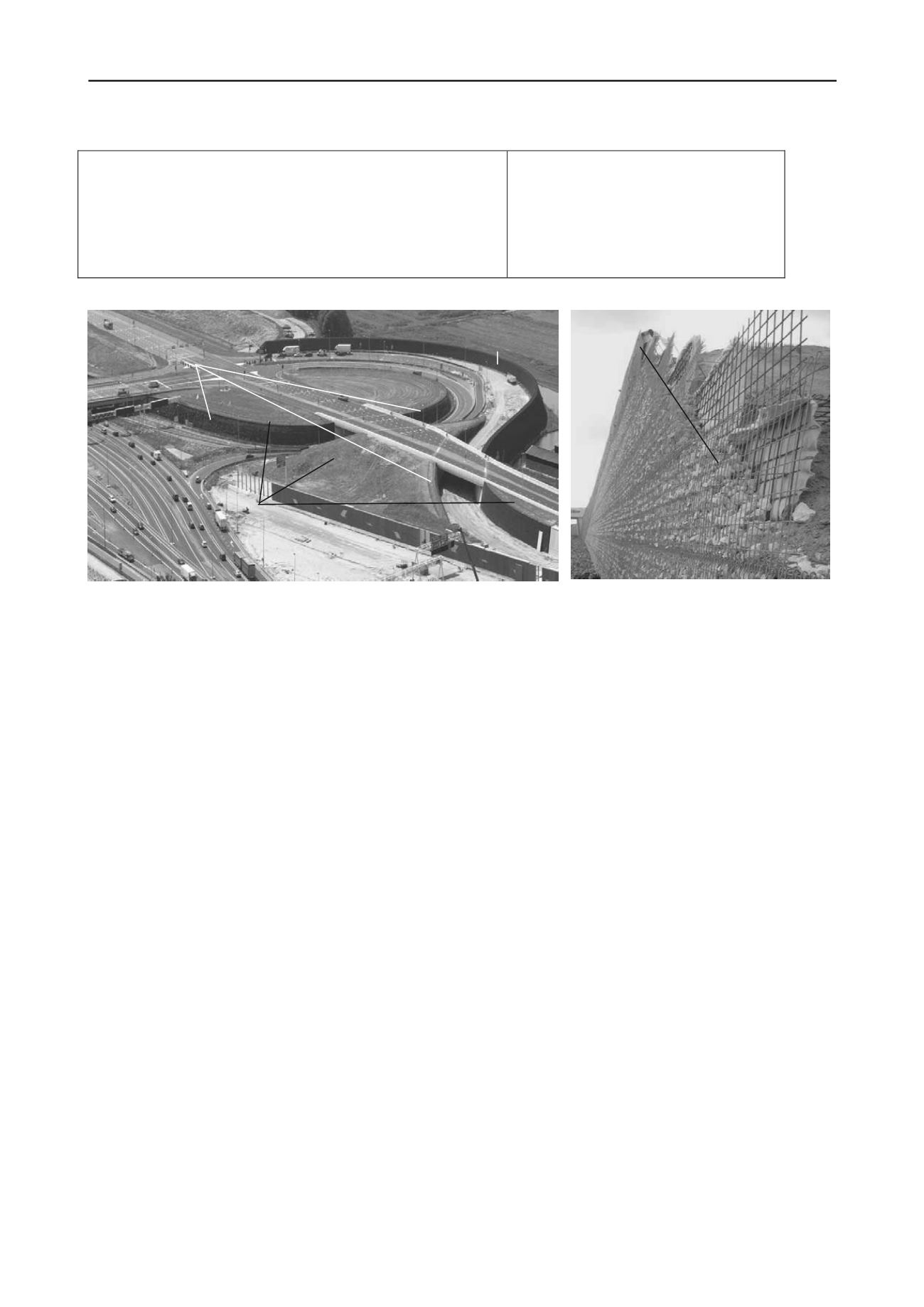
3214
Proceedings of the 18
th
International Conference on Soil Mechanics and Geotechnical Engineering, Paris 2013
Table 1. Deformations to be expected for reinforced walls (according to Herold, 2007)
Max. horizontal deformation:
Total:
h
total
= 0.005 … 0.01 * H
Post-construction:
h
post
= 0.15 … 0.3 * h
total
= 0.00075 … 0.003 * H
Max. vertical deformation:
Total:
v
total
= 0.01 … 0.02 * H
Post-construction:
v
post
= 0.15 … 0.4 * V
total
= 0.0015 … 0.008 * H
- H: max. height of construction;
h: horizontal deformation;
v: vertical deformation
- all deformations within the construction;
- to be added by subsoil settlements;
- lower boarder for walls without surcharge,
upper boarder with surcharge.
Figure 5. De Krul, Netherlands, overview (Vollmert et al., 2010)
Figure 6. Double wall system (System NAUE DW)
The long-term serviceability depends therefore on usual and
well known construction materials as steel and concrete.
Nevertheless, the stability of the construction shall be ensured
even in case of partial damage, e.g. following accidents, fire or
vandalism or the construction has to be designed properly and
protected by crash barriers.
It is the unique characteristic of reinforced walls that the
internal stability can nearly never collapse by stress on the
facing. Providing facing systems that can be repaired easily
therefore give additional benefit for the maintenance of the
structures.
An intelligent and lean facing system, combining the aspects
of economic design and easy to maintain, has been realised at
the project Wien (Fig. 6), differentiating the static support
system on the soil side and the galvanised steel grid on the
facing side. The gap is filled with natural stone in analogy to
gabions. In case of a damage of the outer steel grid, the structure
remains stable and just the filling and outer steel grids have to
be reconstructed.
5 FINAL REMARK
Extending and reconstructing the infrastructure within the
European countries as well as the international routes, structures
for noise barriers and embankment foundations are required,
fulfilling the economic requirements. Geosynthetics, namely
geogrids, allow to use local soils and can be combined with
steel elements as well as concrete and wooden elements.
The experience and scientific findings gained in the last two
decades ensure a sophisticated level of engineering as
documented in the design codes EBGEO and BS 8006, both in
accordance with Eurocode 7. Nevertheless it should be noted
that Eurocode 7 alone does not provide full sets of partial
factors, so additional factors provided by EBGEO and BS 8006
are strongly recommended to be used depending on the specific
national used design approaches.
6 REFERENCES
Corney, N., Cox, P., Norgate, S. & Thrower, A. (2009): Sustainable
Geosystems in Civil Engineering Applications. WRAP, Banbury,
July 2009.
Egloffstein, T. (2009): Bauverfahren mit mineralischen Baustoffen und
Bindemitteln im ökologischen Vergleich mit dem Einsatz von
Geokunststoffen. 6. Geokunststoff-kolloquium, NAUE GmbH &
Co. KG, Bad Wildungen, January 2009.
Heerten, G., Vollmert, L. & Klompmaker, J. (2009): Geomechanical
behaviour of geogrids – current design and future aspects of
research linked to the rheological behaviour of compound material.
9th International Geotechnical Conference - Geotechnical
Monitoring, Bratislava, June 2009.
Herold, A. (2007): 10 Jahre Verformungsbeobachtung an KBE-
Bauwerken – Ist die Dehnsteifigkeit der Geokunststoffe der
Schlüssel zur korrekten Prognose des Verformungsverhaltens von
KBE-Stützbauwerken? geotechnik, Heft 30, 2007.
Kempfert, H.-G. (2011): Das Normenhandbuch. RuhrGeo Tag:
Eurocode 7, Einführung in Deutschland, TU Dortmund, Heft 30,
2011.
Klompmaker, J. & Werth, K. (2011): Introduction of EC7 - Comparison
of calculations following EBGEO and BS8006 in accordance to
EC7. Parametric study for NAUE GmbH & Co. KG, unpublished.
Pachomow, D., Vollmert, L. & Herold, A. (2007): Der Ansatz des
horizontalen Erddrucks auf die Front von KBE-Systemen.
Tagungsband zur 10. FS-KGEO, München, 2007.
Ruiken, A., Ziegler, M., Vollmert, L. & Duzic, I. (2010): Recent
findings about the confining effects of geogrids from large scale
laboratory testing. 9th International Conference on Geosynthetics,
Brazil, 2010.
Vollmert, L., Ramkema, A. & Verhoeff, G. (2010): Geokunststoffe und
deren Bedeutung für großräumige Infrastrukturmaßnahmen am
Beispiel des Knotenpunktes Hoogelegen der A2 Utrecht-
Amsterdam. 31. Baugrundtagung, München, November 2010.
Wessling, A. & Vollmert, L. (2004): Geogitter bewehrte Steilböschung
spart Kosten. Straßen & Tiefbau, Heft 11/2004.
Reinforced embankment and noise
barrier wall
System UTRECHT
Stone-fill between front- and
backside-steel-mesh
Green reinforced walls
System NAUE WRAP
" 2 x 5 " lanes
Soil fill for noise
reduction


